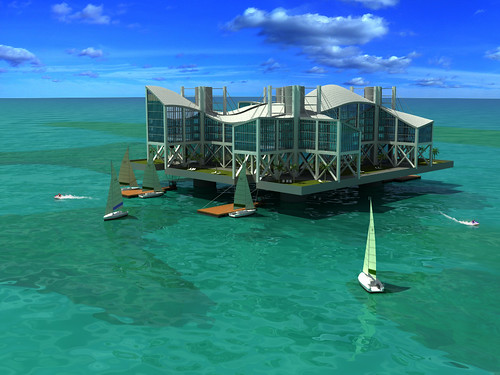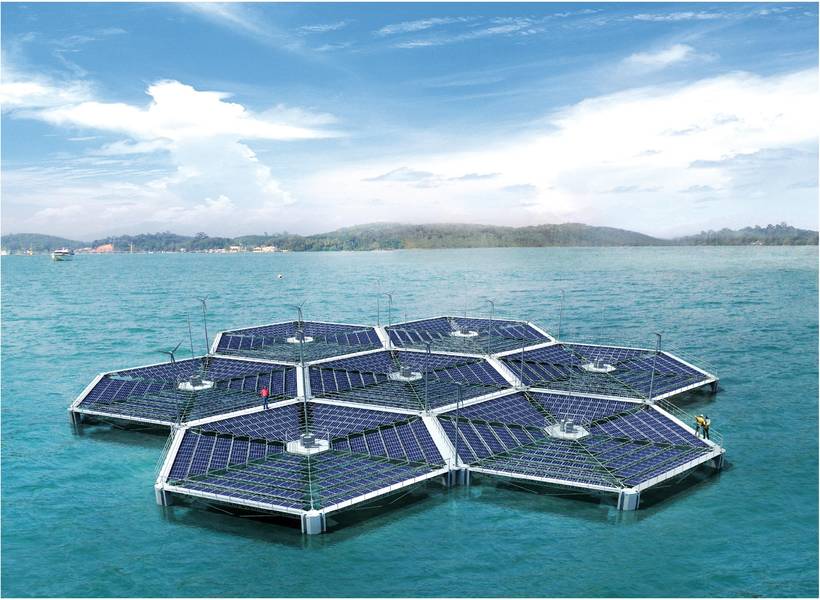Our oceans are vast, they cover the largest part of our planet. Water isn’t scarse nor are nutrients needed for agriculture. Oceans contain gasses like CO2 in higher concentrations than our athmosphere. The largest part of our oceans are free, it is simply to expensive and cumbersome to patrol them. With our present technology they should be considered a new frontier with amazing potential. What is needed for exploitation or use is mainly technology. Economic considerations (Return on fossil investment) prohibit this at the moment, although ocean farming is on the rise.

Our oceans can be farmed by autonous systems, for ecological gain..
That would be the result if we used renewables and autonomous vehicles to develop and farm on our oceans. Clams, Algae and seaweed grow on simple wires floating in the photonic zone. Nutrients are found deeper under water, and schemes to farm large amounts of algae for carbon sequestration and other uses have included wind or waver driven pumps to bring nutrients to the surface. Below an example of a design for a ‘Ocean Nutrient Enhancer’ which causes algae to grow in the top layer and thus provides food for organisms higher up the food chain. The effectiveness of this approach has been disputed, but not based on any real agruments. On the other hand it’s a well known fact that the maritime abundance in coastal zone is caused by wind driven upwelling of deep ocean nutrients. Several experiments with this type of natural fertilization remained inconclusive or where terminated prematurely.

The oceans aren’t only an underutilized source of farmed biomass, it’s current state is precarious due to the buildup of CO2 in our atmosphere and resulting rise in termperature. The CO2 dissolves and makes the water more acid, making it harder for plants and shelled animals to live let alone thrive. The rising temperatures at the poles means less oxygen gets disolved and currents carrying oxygen to the deep oceans are slowing down. Ultimately warmer oceans stratify, form two layers, with a warm nutrient poor top, and a cooler nutrient rich bottom. This means nothing can live in it, and it may take millions of years before life returns. This has happened several times in our planet’s history, most importantly during the end permian extinction.
Extraeconomic approach
Taking a different view of our role vis a vis our oceans would be a great step towards making a dent in the current delapidation of our chances of survival of our species. The extraeconomical approach creates value without the desire to exploit. If one wants to start an enterprise on the big blue the normal challenge is to write a business case that convinces investors and or banks to put in their money. They then expect a return. This route ensures maximal protection of existing bank interests. It also ensures that value created is maximally exploited. For example, the durchrainmaker firm designs a windmill that produces 6000 liters of water a day for 10.000 Euro. Obviously this low tech solution against water scarcity affects the budding water market, eyed by financial experts as a mouthwatering prize and instrument to enslave entire nations. So the solution is to demand a much bigger model, to be sold for 700.000 Euro or so, so that the rainmaker and its producer become an items for speculative bidding, ensuring the cost per liter rise to the prevailing market price, destroying the reason why one would invest in a rainmaker as long as there is fossil fuel to achieve the same end. That is economics. No easy free water for you africans!

I the same way any plan for large scale ocean farming would only happen as long as it would not affect the cashflow of current market participants. So it needs to be done outside our economy, outside the influence of banks and investors, which by accident, because of the vastness and unpoliceability of our oceans, perfectly possible. The extraeconomic approach would set out to create a oceanic domain wich operates autonomously and besides execution of a core activity provides for itself. So the ocean West of Hawaii would see millions of acres of automatic seaweed farming using deep ocean nutrients, but none of the biomass would be sold on the markt, it would be used to sequester carbon, feed fishfarms, make ocean life thrive, keep the workers of the economy alive. Perhaps feed people working on other extraeconomical projects like afforestation fo deserts. But no bank would own a patent, be able to leverage assets, sell seaweed futures or any of that nonsense. The aim would be to make our oceans healthier, our atmosphere cleaner and cooler (one of the effects of large scale seaweed farming). This would provide many people with a decent living as well.
Robotic future
Like the potential of our oceans, the sun and the wind, we also underestimate the potential of robotics to do benificial things. By the same rules of the business case no company will be allowed to build a robot that simply works the land, plants and havests, and provides us with food. It can be done, but our financial world is not interested in assisting in solving our primay existential problems, how are we going to work if we have free automatic food. The robots can be made of cheap materials, a common notebook control activity even in a large farm, sure it would take some effort, but our farming methods after a century of progress are better characterized as a donkey for oil, genpatent and chemical companies than the most solid and robust way to ensure we have something to eat. War in the Middle East would cause massive casualties due to starvation, just because the farming industry was loaded with fossil dependence, chemical and genetic monoculture, and the dead soil would not bring forth one edible gram wheat without the toxic mix applied to it no. We wrote about the 5 year post petrol food gap, meaning, if fossil fuels are not available it will take 5 years for land to produce food.

Can solar parks float? Of course! (sunengy)
Doing it better would mean solving problems, not perpetuating them for exploitation. Robotic technology would be perfect for that. Robots runninig on renewables would be even more perfect, because they would run forever. This is the robo part in the term roboeconomy. Robots restoring the ecosystem running on renewable energy. The biggest obstacle to this future is our fossil dependence, not so much because we continue to pollute if we use it, but because it is an instrument of control over what we can and what we can’t do. Only when we work with our own money or with owned resources or with renewable energy that we create ourselves can we freely operate and disrupt the market. Then it is easy to set up extra economical zones. Now we are constantly inhibited by a banking system that simply wants to remain in contol.
We depend on individuals like the creator of the DonQ windturbine or the Dutch Rainmaker to build concepts because they offer an easier way to live, because they bring an opportunity for real wealth, but once we recognize the inhibiting effects of banks and fossil energy companies we may unite to create engines of wealth that break their power. Not by going more labour intensive (as is usually advocated), but by going automatic based on renewables. We have the technology, we need to use it to the best effect. Then the twentieth century fossil fuel glut will have been good for something, it enabled us to create the tools to mitigate the damage of our primitive economic approach.